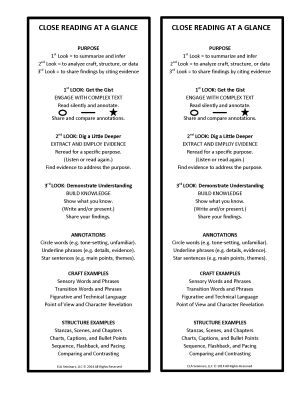What is close reading?
Close reading is a strategy which requires students to read and revisit short, complex passages. Its purpose is to help students uncover layers of meaning that lead to deep comprehension.
The Partnership for Assessment of Readiness for College and Careers (PARCC) has endorsed close reading as a teaching strategy to help young readers “stay in the text” to determine the meaning of words, to examine key phrases, and to identify important statements.
What are the basic steps for conducting a close reading session?
The four basic steps for conducting a close reading session are:
1. Read a short passage – using a pencil to mark words, phrases and sentences.
2. Share notations with others.
3. Reread with a purpose.
4. Respond to a discussion-worthy, text-dependent question.
Do close reading passages have to be short?
Yes. Short pieces allow students to digest and analyze challenging passages in a single class period.
.
.
Should background information be provided before conducting a close reading activity?
No. When students read a passage for the first time, they should approach it with a sense of discovery by formulating questions and making observations. As students self-select interesting words, phrases, and sentences from the text, they learn how to uncover meanings of unfamiliar words, determine an author’s tone, and identify key points independently.
Why are students required to read the same passage multiple times?
Students read once to get the gist of the short text. During the first reading, students mark the text or make notes in the margins.
Before asking students to reread the text, the teacher gives students a purpose for reading in order to take them more deeply into the text. This strategy helps students to process information which is intended to change perceptions or build knowledge.
The final look into the text requires students to show what they know by finding information that will be shared or recorded.
Do the architects of the Common Core State Standards provide a framework for conducting a close reading?
No. Close reading strategies vary depending on text complexity, grade level, and learning objectives.
However, close reading always involves three things: rereading, annotating, and finding text-dependent evidence.
How does close reading support the Common Core State Standards?
Students activate nine of the reading standards during a close reading activity.
Standards one through three require students to read text in order to identify central ideas and supporting details.
Standards four through six ask students to examine how the passage was written to help establish a reading/writing connection.
And standards seven through nine invite students to compare, contrast, and assimilate new knowledge.
.
Are there close reading “cheat sheets” available?
Yes. You can download a set of close reading reference cards here:
Download “Close Reading at a Glance” reference cards at http://elaseminars.com/images/CLOSE-READING-AT-A-GLANCE.pdf
For more information about close reading, visit http://bit.ly/1jn06uD and http://bit.ly/1fdAi3m
.
Until next time…stay committed…teach with passion…and inspire students with who you are.
.
About me (Janice Malone): I’m a teacher, an in-service provider, and the owner of ELA Seminars. For more information, visit www.ELAseminars.com.
Share Point: Okay, now here’s a quick survey question for you:
Do you think close reading strategies hurt or help the quest to nurture lifelong readers?
Type HELP or HURT in the comment section below.




Help
I love the idea especially for nonfiction, but I wish there was a way to teach “love” of reading.
Wouldn’t it be wonderful if teachers could purchase Love-of-Reading Magic Wands?